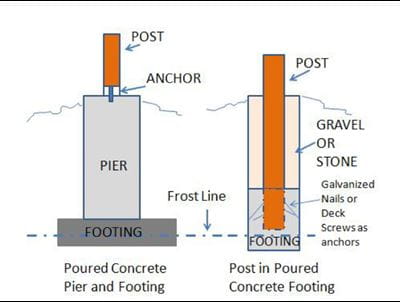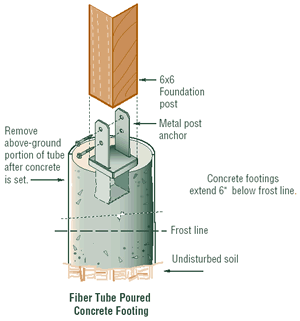Important Tips for Solid Deck Footing: A Comprehensive Guide
Building a deck is a financial investment that calls for mindful planning and attention to detail, specifically when it comes to the footing. This overview will cover critical elements such as selecting the best materials, assessing soil problems, calculating tons ability, identifying correct footing depth, and accomplishing precise setup. Allow's dive right into the world of solid deck footing and establish a foundation you can depend on.
Picking the Right Deck Footing Materials
When selecting the appropriate deck ground materials, it is necessary to consider the particular needs and requirements of your job. The top quality and resilience of the footings directly affect the security and longevity of the deck structure. When selecting deck footing materials., there are several elements to think about.
Clay dirts have a tendency to maintain water, while sandy soils drain pipes promptly. Comprehending your soil conditions will certainly aid you choose grounds that can properly sustain the weight of the deck and stop problems such as sinking or heaving - Deck Footings.
Another variable to think about is the climate in your region. Extreme temperature levels, dampness levels, and freeze-thaw cycles can affect the efficiency of deck footings. In cool environments, for example, frost heave can cause footings to split or change. In such situations, utilizing frost-resistant materials or installing footings below the frost line can help minimize these risks.
Additionally, the size and style of your deck must also influence your selection of footing products. Larger or even more intricate decks may need much deeper or strengthened grounds to guarantee adequate assistance. Recognizing the certain load requirements of your deck will aid you identify the suitable materials to use.
Eventually, choosing the appropriate deck ground materials entails careful consideration of factors such as soil conditions, climate, and deck layout. By taking these factors right into account, you can choose grounds that give the needed assistance, boost the stability of your deck, and ensure its long life.
Effectively Evaluating Soil Problems
To correctly assess soil problems for your deck footing, it is essential to extensively evaluate the load-bearing capacities and water drainage properties of the soil in your area. Comprehending the soil's capability to bear weight and its capability to drain pipes excess water will help guarantee the security and durability of your deck.
When examining the load-bearing capability of the soil, it is vital to think about factors such as dirt thickness, type, and compaction. Different soil types have varying load-bearing capacities, with compacted dirts normally supplying far better support than sandy or loose dirts. Conducting a dirt test can provide beneficial details about the soil's capacity to sustain the weight of your deck.
Additionally, evaluating the water drainage properties of the soil is necessary to avoid water build-up and potential damage to your deck - Deck Footings. Poor drainage can result in moisture buildup, which can compromise the structure and create structural concerns. It is very important to evaluate the soil's capability to drain water properly to prevent these troubles
Consulting with a professional designer or dirt expert can considerably help in appropriately evaluating dirt problems for your deck ground. They can give experienced recommendations and guidance, making sure that you select the suitable footing layout and products based on the details characteristics of the soil in your area. Taking the time to thoroughly analyze dirt conditions will certainly assist you develop a resilient and solid deck.
Computing Tons Capability for Footings
One important action in ensuring the security of your deck is to precisely calculate the lots capacity for your footings. Deck Footings. The tons capability describes the maximum amount of weight or load that the grounds can securely support without causing any structural damages or failure. Determining the tons capacity for footings involves taking into consideration numerous variables such as the dimension and kind of footings, the sort of dirt, the measurements and weight of the deck, and the online tons and dead load that the deck will go through
To compute the load capability, it is very important to consult neighborhood building regulations and regulations as they offer details standards and requirements for deck construction. These codes take right into account aspects such as soil bearing capability, frost deepness, and minimum footing measurements. Additionally, it is critical to engage the services of an architectural designer or a specialist service provider that can do the needed calculations and analyses to guarantee the security and security of the deck.
When determining the tons ability, it is necessary to properly establish the real-time lots and dead lots that the deck will certainly experience. The online tons describes the weight of individuals, furniture, and any kind of other items that will be positioned on the deck, while the dead lots describes the weight of the deck itself. By properly determining these loads and taking into consideration all relevant factors, you can make sure that your grounds are effectively developed to support the weight and preserve the stability of your deck.
Guaranteeing Correct Footing Deepness
Appropriate ground depth is critical for making sure the security and long life of your deck. The deepness at which the footings are installed straight affects the structural integrity of the deck, as it identifies just how well the grounds can resist the pressures put in by the deck and the dirt underneath it.
When determining the ideal ground deepness, a number of variables must be considered. In locations with extensive clay dirt, deeper footings might be required to give appropriate support.
To figure out the proper ground deepness, it is suggested to talk to an architectural designer or structure assessor that can evaluate the details problems of your website and supply advice based on regional building regulations and regulations. They will think about factors such as soil composition, aquifer degree, and expected loads to establish the minimum needed footing depth.
Installing Footings With Precision
Setting up grounds with precision is crucial for ensuring the stability and architectural integrity of your deck. Properly set up footings supply a solid structure, making sure that your deck can original site hold up against the weight of furniture, people, and other tons. To install grounds with accuracy, there are several crucial steps to comply with.
To start with, it is essential to properly mark the place of each ground. This can be done by utilizing a string or chalk line to create a clear synopsis. By measuring and marking the exact settings, you can make sure that the footings are evenly spaced and straightened.
Following, you need to dig the holes for the footings. It is critical to dig them to the proper depth and size, as defined by regional building regulations and policies. This will provide ample assistance and protect against the deck from moving or sinking over time.
As soon as the openings are dug, it is essential to level and small the dirt at the end of each opening. This will create a steady base for the ground to rest on and go avoid any settling or motion.
After preparing the holes, you can proceed with pouring the concrete. Utilize a concrete mix that appropriates for footings and follow the supplier's directions for mixing and pouring. Guarantee that the concrete fills up the openings entirely and is level with the ground surface.
Finally, enable the concrete to treat appropriately before continuing with the building and construction of your deck. This will certainly ensure that the footings are strong and stable, providing a protected structure for your deck.

Conclusion
To conclude, making sure strong deck footing is important for the security and long life of a deck framework. By selecting the proper footing materials, assessing dirt conditions, calculating tons ability, and setting up footings with accuracy, the risk of structural failing can be decreased. Complying with these vital pointers will certainly help develop a strong foundation for any kind of deck job.
Comprehending your soil problems will assist you choose footings that can successfully sustain the weight of the deck and avoid concerns such as sinking or heaving.
Consulting with a professional engineer or soil professional can significantly aid in properly assessing dirt problems for your deck ground. Computing the tons capability for grounds involves considering different elements such as the size and type of grounds, the type of dirt, the measurements and browse around this site weight of the deck, and the live load and dead tons that the deck will certainly be subjected to.
